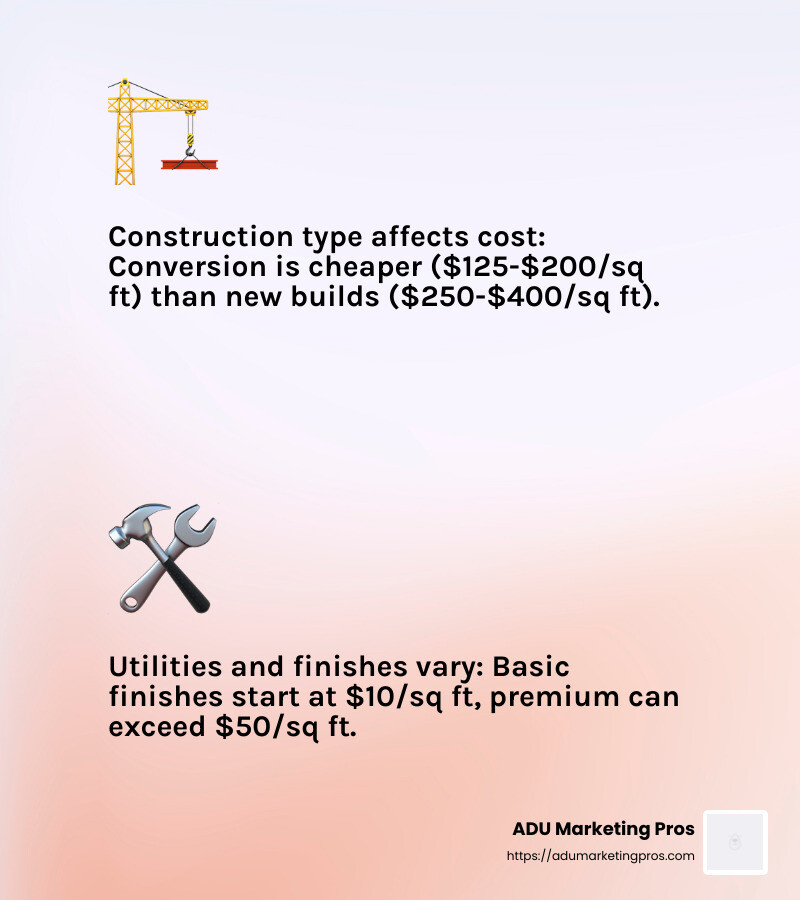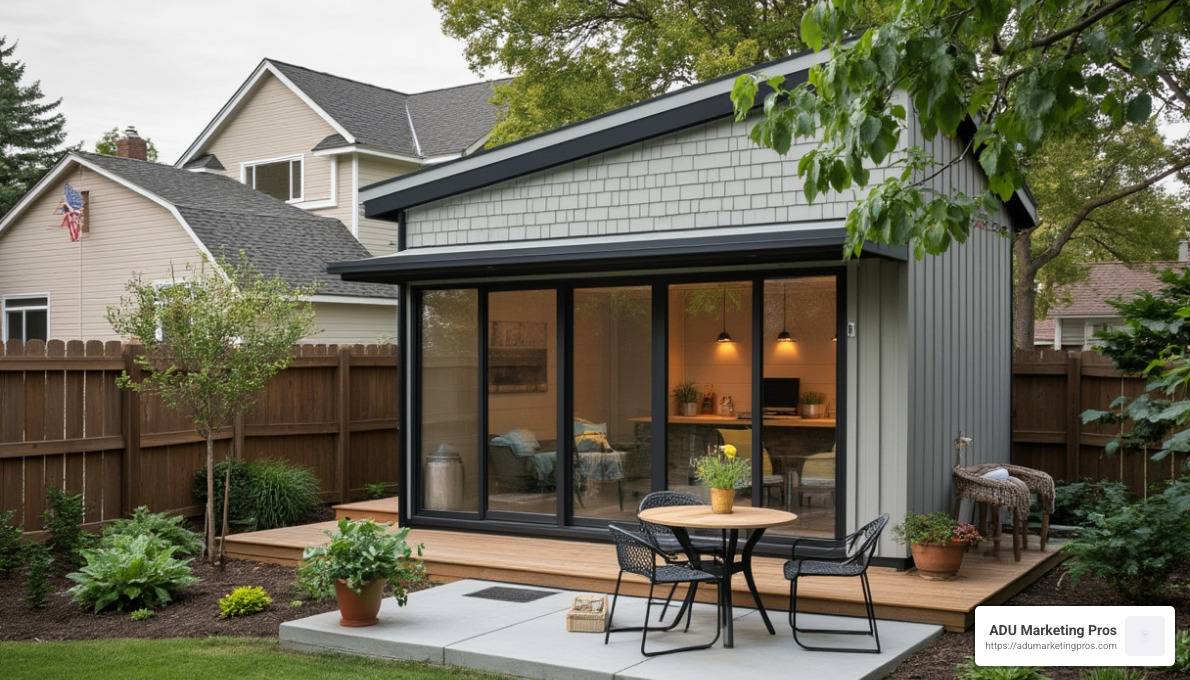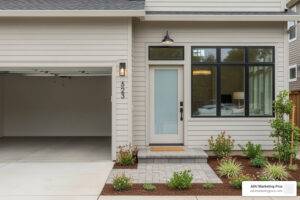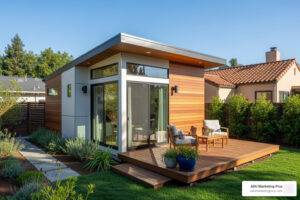ADU cost calculator searches are gaining traction as homeowners increasingly explore the potential of adding accessory dwelling units to their properties. If you’re curious about the costs, here’s the gist:
- Hard Costs: The tangible expenses of construction—think labor, materials, and fixtures.
- Soft Costs: Permits, designs, and consultation fees that often surprise new builders.
- Contingency: Additional funds (5-10% of total costs) to cover the unforeseen.
Building an Accessory Dwelling Unit (ADU) involves more than just laying bricks and mortar; it demands a nuanced understanding of associated costs and a well-strategized budget. Homeowners often grapple with the complexity and variability of expenses, which can easily lead to uncertainty and hesitation.
To bridge this gap, an ADU cost calculator emerges as a valuable ally. By providing a rough estimate, it helps potential builders make informed decisions, focusing on budgets and construction outcomes.
While the calculator offers a helpful starting point, it’s crucial to recognize that costs can fluctuate based on factors like size, design, and local regulations. Understanding these elements can empower homeowners and builders to start on their ADU journey with clarity and confidence.

Understanding ADU Costs
When planning to build an Accessory Dwelling Unit (ADU), understanding the costs involved is crucial. The cost per square foot is a primary consideration, typically ranging from $125 to $300. However, some projects can soar as high as $600 per square foot. This variance depends on several factors, including construction type, lot slope, utilities, and interior finish.
Construction Type
The type of construction has a significant impact on the overall cost. Converting existing spaces like attics or garages is usually more cost-effective, ranging from $125 to $200 per square foot. New constructions, on the other hand, can be more expensive, with costs between $250 and $400 per square foot. Factors such as the need for new foundations or additional structural elements can drive up expenses.
Lot Slope
The slope of the lot plays a critical role in construction costs. Building on a flat lot is generally less expensive. In contrast, sloped lots might require additional work like grading or installing retaining walls, increasing the cost by about 25%. Accessibility issues can also add to the complexity and expense of the project.
Utilities and Interior Finish
Utilities and interior finishes are substantial contributors to the final cost. The price of electrical, plumbing, and HVAC systems can vary based on the complexity and quality desired. Interior finishes further differentiate the cost:
- Basic: Entry-level utilities and appliances, typically costing $10 to $20 per square foot.
- Standard: Includes high-quality finishes like stainless steel appliances and granite countertops, ranging from $20 to $40 per square foot.
- Premium: Top-of-the-line finishes and appliances, starting at $50 per square foot.

Understanding these cost factors can help you use an ADU cost calculator effectively. By accounting for these variables, you can create a more accurate budget and anticipate potential expenses, ensuring a smoother construction process.
The Role of an ADU Cost Calculator
An ADU cost calculator is a powerful tool for homeowners looking to estimate the cost of building an Accessory Dwelling Unit. It helps simplify the complex budgeting process by providing a rough estimate based on several key factors. This tool is invaluable for anyone looking to manage their project estimates and budgeting effectively.
Project Estimates Made Easy
The primary purpose of an ADU cost calculator is to give you a ballpark figure for your project. By inputting details like the size, type of construction, and interior finishes, the calculator provides an estimate that reflects the potential costs. While it’s not exact, it offers a starting point to understand the financial scope of your ADU project.
Budgeting with Confidence
Budgeting for an ADU can be daunting due to the various costs involved. Hard costs, such as labor and materials, and soft costs, like permits and design fees, add up quickly. The calculator helps you see these costs side by side, so you can plan your budget more effectively. It even accounts for a contingency budget, which is crucial for covering unexpected expenses.

How It Works
To use an ADU cost calculator, you’ll need to provide specific information about your project. This includes:
- ADU Size: Larger units typically cost more per square foot.
- Construction Type: Whether it’s a conversion or new construction affects the cost.
- Lot Conditions: A flat lot is cheaper to build on than a sloped one.
- Utilities and Interior Finish: Choices here can significantly impact the budget.
By entering this data, the calculator estimates the total cost, helping you make informed decisions about your ADU project. It also allows you to adjust variables and see how different choices affect your budget.
In summary, an ADU cost calculator is essential for anyone considering an ADU project. It provides a clearer picture of potential costs, helping you budget smarter and steer the financial aspects of your construction with greater ease.
Key Factors Influencing ADU Costs
When planning an ADU, several factors will influence the overall cost. Let’s break down the key elements that can impact your budget.
ADU Size
The size of your ADU plays a significant role in determining the total cost. Larger ADUs generally have a higher cost per square foot. This is because they require more materials and labor. For example, a 900 square foot ADU will cost more than a smaller unit, but it can offer more living space and potentially higher rental income.
Construction Type
Conversion vs. new construction is another crucial factor. Converting an existing space, like a garage, can be cheaper than building a new structure from scratch. However, the cost savings depend on the condition of the existing structure and the required modifications. New construction, while often more expensive, allows for more customization and modern features.
Lot Conditions
The condition of your lot can significantly affect construction costs. Building on a flat lot is typically less expensive than on a sloped lot. A sloped lot may require additional grading, retaining walls, or foundation work, all of which increase the overall cost.
Utilities and Interior Finish
The choice of utilities and interior finishes can also impact the budget. Installing electrical, plumbing, and HVAC systems is essential, but the quality and type of these systems can vary widely in cost. For instance, opting for energy-efficient appliances and systems may have a higher upfront cost but can lead to savings on utility bills in the long run. The interior finish, whether bare, mid-level, or luxury, will also affect the total expense.
Understanding these factors and how they influence costs can help you plan your ADU project more effectively. By considering each element, you can make informed decisions to balance your budget with your desired outcomes.
How to Use an ADU Cost Calculator Effectively
Using an ADU cost calculator is a smart move for anyone planning to build an Accessory Dwelling Unit. This tool helps you estimate the costs involved, set a realistic project budget, and understand potential rental income and return on investment (ROI).
Estimate Your Costs
Start by entering the details of your project into the calculator. You’ll need to include the size of your ADU, the type of construction, the lot conditions, and your preferred interior finishes. This will give you a rough estimate of the costs involved, helping you plan your finances better.
Set a Project Budget
Once you have an estimate, it’s time to set a project budget. Make sure to include both hard costs (like materials and labor) and soft costs (such as permits and design fees). Don’t forget to add a contingency budget of 5-10% to cover unexpected expenses. This ensures you’re prepared for any surprises during construction.
Calculate Potential Rental Income
If you’re planning to rent out your ADU, use the calculator to estimate potential rental income. This involves researching rental prices in your area for similar units. A larger ADU might fetch higher rent, but it will also cost more to build. Balancing these factors is key to maximizing your income.
Evaluate Return on Investment
Finally, consider the return on investment. Compare the estimated costs with the potential rental income to see how long it will take to recoup your investment. A well-planned ADU can provide a steady income stream and increase your property’s overall value.
Incorporating these steps when using an ADU cost calculator can help you make informed decisions, ensuring a successful ADU project. By understanding the financial aspects, you can confidently move forward and achieve your goals.
Frequently Asked Questions about ADU Costs
How much does a 900 square foot ADU cost?
The cost of a 900 square foot ADU can vary significantly based on several factors. On average, you might expect to spend anywhere from $100,000 to $300,000. This cost range depends on the location, quality of materials, design choices, and local labor rates. For instance, building in a city with high construction costs, like Los Angeles or San Francisco, could push the price toward the higher end. That larger ADUs generally have a lower cost per square foot compared to smaller ones due to economies of scale.
Is it cheaper to build an ADU or add an addition?
When deciding between building an ADU and adding an addition to your existing home, it’s important to consider both cost comparison and infrastructure needs. Typically, building an ADU might be more cost-effective if your goal is to generate rental income, as it functions as a separate unit. However, adding an addition can sometimes be cheaper if you simply need more space for your family. An ADU requires separate utilities like plumbing and electrical systems, which can increase costs. But it also offers the flexibility of a standalone unit, potentially increasing your property’s value and offering efficiency in terms of rental income.
What are the soft costs associated with ADU construction?
Soft costs are a crucial part of any ADU project budget. These are non-physical expenses that encompass planning and regulatory requirements. Here are some key soft costs to consider:
-
Boundary Survey: This survey outlines the property boundaries, ensuring compliance with zoning regulations. It confirms property ownership and is essential for avoiding legal issues.
-
Design Fees: These include costs for architectural plans and designs. A full set of plans might include floor layouts and structural details, necessary for both construction and permitting.
-
Permitting Fees: These vary widely by location and cover the application for building permits. Some cities might have reduced fees to encourage ADU development, while others maintain higher costs.
Understanding these soft costs helps you plan your budget effectively. They can represent a significant portion of your total expenses, so it’s important to account for them early in the planning process.
Conclusion
In the rapidly growing ADU sector, having the right marketing strategy can make all the difference. At ADU Marketing Pros, we specialize in helping ADU construction and architecture firms stand out in this competitive market. Our focus is on highlighting your expertise over simply competing on price.
We understand that building an ADU involves navigating complex regulations and fluctuating costs. That’s why our custom marketing solutions are designed to attract high-quality leads who appreciate craftsmanship and are ready to invest in premium projects. Our services ensure your firm is the first choice for clients seeking quality and expertise.
By leveraging targeted SEO, PPC, and social media strategies, we help your business connect with homeowners who are eager to build ADUs. Our approach is rooted in continuous market research and data-driven insights, allowing us to adapt quickly to changing regulations and consumer behaviors.
Our ultimate goal is to drive measurable growth for our clients. With a strong, recognizable brand identity, we aim to establish ourselves as the go-to authority for ADU marketing solutions in California. Whether you’re in Los Angeles, San Francisco, or San Jose, we’re here to help your firm thrive in the ADU sector.
For more information on how we can help your business grow, reach out to us for a consultation. Let’s build a successful future together in the ADU industry.




